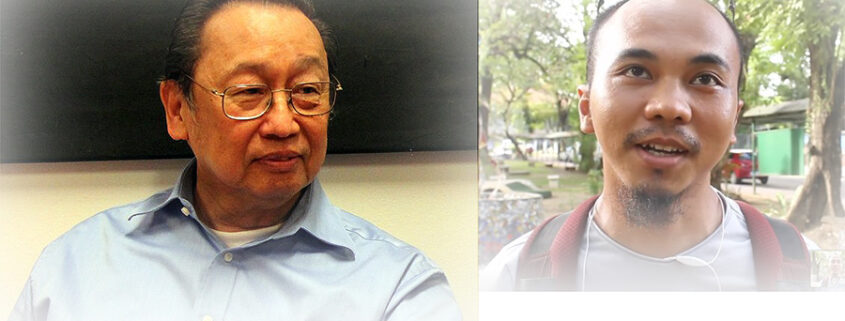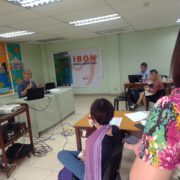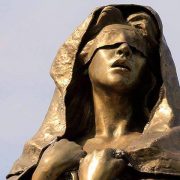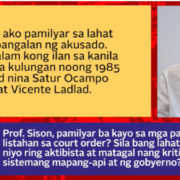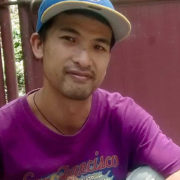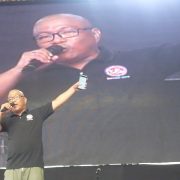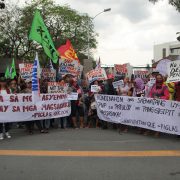On the question of fascism in relation to the Duterte regime
Interview by Prof. Regletto Aldrich D. Imbong
Department of Philosophy, University of the Philippines-Cebu
Prof. Imbong: Not so many intellectuals in the Philippines develop a strong theoretical argument on Duterte’s fascistic tendencies. Many assume rather than argue that Duterte is a fascist. What conditions should be met for one to be considered a fascist?
Prof. Jose Maria Sison (JMS): Any individual, group or movement can be fascist or have fascist tendencies in mentality, advocacy and behavior and is usually motivated by rabid anti-communism, a key factor that is ingratiating to the big bourgeoisie, especially the imperialists. But for an entire government or regime like that of Duterte to be described as categorically fascist and not merely having fascistic tendencies entails certain considerations and requirements.
To be fascist, the government or regime must be rabidly anti-communist and rule by open terror in the service of the big bourgeoisie (be it the comprador big bourgeoisie in the Philippines or the industrial monopoly class as in Hitlerite Germany) even as it uses demagogically nationalist, racist or even pseudo-socialist slogans to deceive the people. Most importantly, it has promulgated fascist laws to carry out the violent suppression of any opposition and prevent it from any recourse to the democratic rights guaranteed by a liberal democratic or socialist constitution.
The Duterte regime commits acts of state terrorism on behalf of the worst part of the Philippine big bourgeoisie but it has not yet reached the point of getting rid of the Bill of Rights and other relatively democratic provisions of the 1987 Constitution. However, Duterte is now on the verge of making his regime categorically fascist by enacting the so-called Anti-Terrorism Bill which practically gets rid of the Bill of Rights and is worse than the Marcos martial law proclamation in1972. He can also make charter change to formalize and entrench fascist dictatorship as Marcos did in fixing the 1973 Constitution and faking the referendum to ratify it.
Prof. Imbong: In several interventions, Walden Bello argued why Duterte is a fascist. His claim is that Duterte is a fascist original. By this I understand that right from the start Duterte is a fascist and that the (extreme) Left, being an initial ally of Duterte helped in Duterte’s ascension into the heights of fascist power. Classical fascism, however, is essentially an anti-communist movement (as pointed out by Enzo Traverso), a reaction or mobilization of the middle class and nationalist bourgeoisie against the internationalist working class. In this case, Duterte’s early presidency would not count yet as being fascistic. Could you give a comment on this claim of Bello and the role of the Philippine Left, in general, concerning Duterte’s fascism?
JMS: You are correct in saying that Duterte could not have been described as fascist or fascistic within the first six months of his presidency, especially if you evaluate him or his regime according to Enzo Traverso’s definition of classical fascism as being essentially an anti-communist movement that is a reaction or mobilization of the middle class and nationalist bourgeoisie against the internationalist working class. Duterte had to unfold himself first as a fascist or fascistoid in contradiction with his avowals of being “Left” and “socialist”.
You are correct in saying that Walden Bello is wrong for claiming that he knew Duterte as a fascist even before any manifestation of his being a fascist by word or deed. Before becoming president, Duterte never manifested himself as an adherent of fascism and was never the leader or member of a self-proclaimed fascist group or movement. As mayor of Davao City, he never declared himself a fascist. He had become vice mayor at first by being appointed by Cory Aquino. At the same time, he maintained close relations with the Marcos crony Floirendo of Tadeco and used him to become mayor.
In the course of his mayorship, Duterte used Dirty Harry tactics to impress the electorate that he was a law-and-order leader and also used violence to kill or silence his political opponents in the course of conflicts among the various political agents of the comprador big bourgeoisie and the landlord class. Among the competing reactionary leaders, he sought to ingratiate himself with the revolutionary movement. In response, the revolutionary movement considered him at the most as an unreliable and unstable ally against those reactionary leaders deemed worse than him on a certain scale of of political and tactical reckoning.
Even though Duterte claimed to be a close friend of the late Comrade Parago and helped in public events to honor him after his martyrdom, there have been questions within the revolutionary movement about Duterte’s close relations with top intelligence officers in the AFP and whether the report from inside the ISAFP that it was he who gave the A-1 information about the whereabouts of Comrade Parago to General Ano. The rapid promotions given by Duterte to Ano when he became president have aroused further the suspicion and investigation of his betrayal of Comrade Parago.
Prof. Imbong: Since the Philippine Left initially started as an ally of the Duterte regime, I believe it initially did not recognize the latter to be fascistic. At what particular point did the Philippine Left begin recognizing and labelling Duterte as a fascist? What were the triggers behind the redefinition of a former ally?
JMS: There was never any alliance between the Duterte regime and the revolutionary movement. In fact, the people’s war along the line of the new democratic revolution has proceeded, despite limited ceasefires to promote the peace negotiations. Warring parties can never be construed as allies until they can conclude at least a long-term truce for the purpose of alliance and other purposes beneficial to the people. The rabid anti-communist Walden Bello makes conclusions that are not based on the facts.
At the beginning of his presidency in 2016, Duterte presented himself as the first “Left” or “socialist” president of the Philippines, wishing to have peace negotiations and a just peace with the NDFP and the Filipino people and promising to amnesty and release all political prisoners. But within a few weeks after assuming his presidential office, he was in effect declaring himself a rabid anti-communist, he was reneging on his promise to amnesty and release the political prisoners and was carrying out the massacre of the poor as suspected drug users and peddlers.
Ka Oris as spokesperson of the CPP promptly criticized and condemned the aforesaid massacre of the poor within June 2016 and I also called Duterte a “butangero” on June 29, 2016 to his face when he was talking tough and reneging on his promise to amnesty and release the political prisoners. He wanted to trick the CPP into recommending certain personalities for four cabinet posts but he appointed them anyway on the basis of their individual merits.
He revealed himself categorically as an incorrigible enemy of the revolutionary movement when he included the CPP and NPA as targets of his martial law proclamation for Mindanao in May 2017. So, since early on, the revolutionary movement has considered Duterte as a rabid enemy and a rabid puppet of US imperialism by surrounding himself with generals who are notorious assets of the CIA and DIA of the US, carrying out immediately an all-out war policy under the cover of continuing Aquino’s Oplan Bayanihan until he launched his own Oplan Kapayapaan in early 2017.
Eventually, the NDFP came to know that when he met Trump in November 2017 Duterte promised to wipe out the revolutionary movement and give US corporations the right to own to the extent of 100 percent any enterprise owning land, exploiting natural resources and operating public utilities and other businesses. He was proving to Trump that he was a loyal puppet to the US despite his posturing as a close friend of China.
Prof. Imbong: Enzo Traverso claims that some of the current populist and rightist movements the world over are irreducible to the classic definition of fascism. These have developed features that do not anymore fit into the classic definition of fascism. He rather called these movements as postfascism. In Brazil also, Jeffery Webber acknowledges the current Jair Bolsonaro regime as a neofascism. Do the current political and economic manifestations of the Duterte regime still fit into the classic definition of fascism? Or is his regime more of what is called as postfascism or neofascism?
JMS: Since the collapse of the Soviet Union and end of the Cold War in 1991, US imperialism has increasingly used the term “terrorism” as the bete noire (black beast) for targetting by the most extreme forms of reaction, including fascist movements, official repressive measures, state terrorism, full blown fascist regimes and wars of aggression. The term “terrorism” is so broad as to encompass not only Islamic jihadists that the US intelligence agencies create but also the communists and other anti-imperialist and democratic forces that are supposed to be the target of “classical fascism”.
The imperialists, the ultra-reactionaries and the fascist movements still vilify their enemy as “communist”, “terrorist” or “communist terrorist” wherever the communist parties and working class movements are relatively strong in the legal struggle and/or the armed struggle and are regarded by the big bourgeoisie as imminent threat to the ruling system. Anti-communism is still a major element in the ideological and political line of fascism, fascist regimes and movements, notwithstanding the imperialist propaganda that communism died in the years of 1989 to 1991.
Duterte points to the CPP as the main enemy of his regime and the main target of his state terrorism. In this regard, he is no different from Mussolini and Hitler and the fascist dictators of China, South Korea, Indonesia and Vietnam after World War II.
In looking at social and political phenomena, I am guided by the laws of contradiction and uneven development. There are generally similar phenomena that at the same time have distinctive dissimilarities or differences. Even at the time of Mussolini the original fascist, Hitler, Franco, Tojo and others, the fascist regimes had generally similar characteristics but also had distinctive dissimilarities.I do not like to play with prefixes like post and neo as some academic pedants do to claim any kind of new and unique discovery.
In my study of fascist movements and fascist regimes that arose before and after World War II, I have observed the following elements in their character and conduct:
1. The fascist groups and movements are ideologically and politically anti-communist and seek and get support from the big bourgeoisie (be it the industrial and financial big bourgeoisie in imperialist countries or the comprador big bourgeoisie in underdeveloped countries).
2. They use xenophobic, chauvinist and racist slogans and target certain racial and ethnolinguistic minorities as the enemy to blame for the suffering and grievances of the people and deflect attention from the exploiting classes.
3. They use the biases of the politically backward section of the masses in order to create the base for their “mass movement”. From this base, they try to influence and win over the middle section of the masses; and try to counter and ferret out communists and other revolutionary forces from the advanced section of the masses.
4. They collaborate with the big bourgeoisie and with the armed apparatuses of the reactionary state in breaking up demonstrations of democratic forces, assaulting workers’ strikes and attacking the persons and properties of people who are communist or progressive in their stand or who belong to any minority deemed as enemy and target of hatred.
5. They ascend to absolute power through elections by taking up the grievances of the people and at the same time enjoying the support of the big bourgeoisie. They can also take power through a military coup against a discredited and weak civilian government. When in power by any degree, they can stage a series of false flag operations to scapegoat the communists and to justify the adoption and implementation of fascist laws.
6. They use the open rule of terror (fascist laws and actions) to suppress any criticism of or opposition to the fascist regime through the adoption and enforcement of laws that comprehensively and profoundly dissolve and violate the basic democratic rights and fundamental freedoms of the people which have been defined and guaranteed by the liberal democratic or socialist constitution.
All the above elements in varying forms and degrees of gravity have characterized the fascist movement and regimes that are employed and supported by the big bourgeoisie upon the failure of conservative and reformist parties, institutions and movement to contain and appease the exploited classes and counter the rise of the revolutionary party of the proletariat and the mass movement that it leads. #

